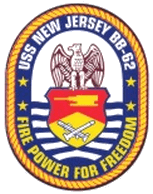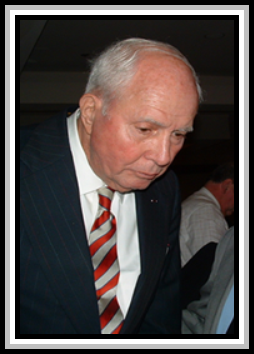Memories Capt. Robert C. Peniston
SECTION 22.
SECTION 22. CONTENTS
Looking Back…
USS Savage (DER-386) by Captain Robert C Peniston, USN/Retired
THE JERSEYMAN Bugler 9 Years - Nr. 69 1st Quarter - 2011
As I look back at my naval career and four sea commands, there are two never to be forgotten storms that come immediately to mind. The first was in USS Savage (DER-386) while on Barrier patrol in the North Pacific . We were on a 24 day rotation, and I recall that our October 1959 patrol was made in fairly decent weather, but the one following in December was to be a very different story.
On 11 December SAVAGE was on northern station and LANSING (DER-388) on the southern station. At about 1200 I received a call from Captain Ozzie Ostlund via the SSB circuit asking me if I thought a DER could be turned 180 degrees in 60-70 knots of wind and with the attendant high seas. My reply was that it would be difficult but that it had been done. Why the question? LANSING had been heading into the high seas when her forward 3”/50 gun tub was torn from the main deck and the Chiefs’ quarters were flooding. Something had to be done, and quickly.
To give some ship’s background, SAVAGE and LANSING were sister Edsall-class DE’s, 300 feet in length with a beam of 36’ 10” and a draft limit just over 20’. Eight officers and 200 men were a normal complement. Propulsion was with 4 Fairbanks-Morse geared diesel engines, at 6000 shp, and with two screws.
I told Ozzie that he would have to get some headway on and then go ahead flank on one engine and astern full on the other throwing the rudder inthe direction of the backing engine. He agreed to try. I then told him to call me back as soon as he had reversed course. If I did not hear from him within 30 minutes I would advise BARPAC and request that a Search and Rescue (SAR) mission be initiated.
Much to the relief of all concerned he called saying that he had brought the ship around, that they were heading down wind, all was well, and they were heading for Pearl. Just one week later, I found SAVAGE in the same situation.
A complex low had formed in the vicinity of the southern station and the weather was deteriorating as I watched the weather front on radar. As soon as the cold front passed, there was a noticeable change in conditions, The wind veered from the southwest to northwest, sea spray engulfed the ship, the seas became confused, the anemometer spun around, heavy rain hit, and worst of all the wind increased in strength. That was enough for me. Our departure time off station was only four hours away so I turned to a southeasterly heading at 15 knots and ran before the storm.
The relative wind speed was clocked between 60-65 knots which meant that the true speed was around 75-80 knots good. It was not an encouraging sight to look astern because it seemed that the gigantic waves would break over the stern. But we managed to keep ahead. I stopped looking aft and told the crew to do the same over the 1MC. I called for our best helmsmen to take the wheel and they did a marvelous job. All was going well until about 2000 when Don Kazimir came to me saying they had to switch generators because the after one needed immediate adjustment. Ordinarily, this is no big deal but when shifting generators there is the chance of losing the electrical load. Under these weather conditions the ship could capsize if it got in the trough and was there for any length of time without power.
Don assembled his top team with Chief Ski [Shupzinski] heading the after group which was the most critical. Once again, I got on the 1MC to advise the crew of what was going on, and ended my announcement with an order for Chief Ski [Shupzinski] to go ahead with it. Within five minutes, and no more, the switch had been made and we continued planing toward Pearl. The weather abated the next day so we continued home with little duress. I think this was the worst storm I had ever witnessed at the time. If not, it was bad enough. We would all do well to remember that the weather is king and we best hold it as such.
Robert C. Peniston, USN (Ret.)
2004

